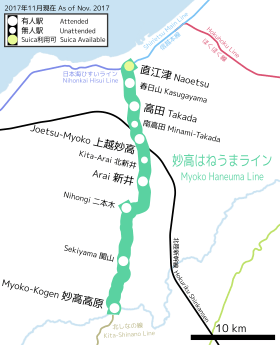Sekiyama Station
Sekiyama Station (関山駅, Sekiyama-eki) is a railway station on the Myōkō Haneuma Line in Myōkō, Niigata, Japan, operated by the third-sector railway operator Echigo Tokimeki Railway.
Sekiyama Station 関山駅 | |
|---|---|
 Sekiyama Station in June 2006 | |
| Location | Sekiyama, Myōkō-shi, Niigata-ken Japan |
| Coordinates | 36.9330°N 138.2265°E |
| Operated by | |
| Line(s) | ■ Myōkō Haneuma Line |
| Distance | 6.4 km from Myōkō-Kōgen |
| Platforms | 1 island platform |
| Tracks | 2 |
| Other information | |
| Website | Official website |
| History | |
| Opened | 15 August 1886 |
| Traffic | |
| Passengers (FY2017) | 142 daily |
| Location | |
 Sekiyama Station Location within Myoko Haneuma Line  Sekiyama Station Sekiyama Station (Japan) | |
Lines
Sekiyama Station is served by the 37.7 km Echigo Tokimeki Railway Myōkō Haneuma Line from Myōkō-Kōgen to Naoetsu, and is located 6.4 kilometers from the starting point of the line at Myōkō-Kōgen and 43.7 kilometers from Nagano.
Platforms
| 1 | ■ Myōkō Haneuma Line | for Takada, Naoetsu, and Niigata |
| 2 | ■ Myōkō Haneuma Line | for Myōkō-Kōgen |
History
Sekiyama Station opened on 15 August 1886.[1] With the privatization of JNR on 1 April 1987, the station came under the control of JR East.[1]
From 14 March 2015, with the opening of the Hokuriku Shinkansen extension from Nagano to Kanazawa, local passenger operations over sections of the Shinetsu Main Line and Hokuriku Main Line running roughly parallel to the new shinkansen line were reassigned to third-sector railway operating companies.[2] From this date, Sekiyama Station was transferred to the ownership of the third-sector operating company Echigo Tokimeki Railway.
Passenger statistics
In fiscal 2017, the station was used by an average of 142 passengers daily (boarding passengers only).[3]
Surrounding area
- Seki Onsen
- Sekiyama Post Office
- Sekiyama Jinja
See also
References
- Ishino, Tetsu, ed. (1998). 停車場変遷大辞典 国鉄・JR編 [Station Transition Directory - JNR/JR]. II. Japan: JTB. p. 582. ISBN 4-533-02980-9.
- Osano, Kagetoshi (March 2015). 北陸新幹線並行在来線各社の姿 [Guide to companies operating conventional lines alongside the Hokuriku Shinkansen]. Tetsudō Daiya Jōhō Magazine (in Japanese). Vol. 44 no. 371. Japan: Kōtsū Shimbun. pp. 28–33.
- 平成29年度の乗車状況(平成29年4月1日~平成30年3月31日)[各駅の1日平均乗車人員 [Station passenger figures (Fiscal 2016)] (in Japanese). Japan: Echigo Tokimeki Railway Company. 2017. Retrieved 1 October 2018.
External links
- Echigo Tokimeki Railway Station information (in Japanese)
- Timetable for Sekiyama Station (in Japanese)